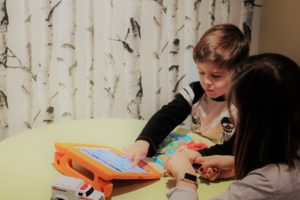This is our second in a series of asking the professionals for information based on their experience in speech therapy. In the first blog post, we asked them if you can really perform speech therapy with toddlers.
In this post we ask a question that I personally get asked a lot. My son was just shy of the major technology boom. Knowing his personality and how easily he adapts to electronics, I am certain that the many apps available today would have been invaluable to him.
But I have seen first-hand the pure joy that a child expresses when they can communicate with a loved one for the first time. It’s so wonderful for them to say “I love you” to mom or dad, even if via a device. It’s a miracle for them to be able to say if they like certain foods or not or get other basic needs met.
But what do the experts say? Can technology really help with speech therapy?
Three experts weigh in!
Yes. There are several ways we can use technology in speech therapy. Currently at CHSC we have two different programs that use visual feedback on the computer to help children/adults get the correct articulatory contacts. So for example, for a person who cannot produce an /r/ sound, probes or a mouth piece are placed in the mouth/on the tongue and the person is able to see what movements their tongue is making on the computer and correct the articulatory placement to produce a correct /r/ sound. We also use iPad in speech therapy and there are numerous different apps for speech, language and stuttering therapy.
Lauren Masuga, M.A. CCC-SLP Senior Speech-Language Pathologist for CHSC
Yes, when used in an engaged therapeutic approach. I use technology and iPad apps allot in my sessions and for home based programming, but they are always used monitored and engaged with a responsible adult. They are always monitored by the adult for accuracy in the process. ASHA does not recommend any screen time prior to the age of 4, and research has shown that screen time prior to age 4 inhibits speech, language and communication development. The use of technology in the form of AAC is a communication building approach that can be used prior to the age of 4, and may be necessary for some children. This, again, is highly monitored by a professional and the parent.
Mary Padula, MA, CCC/SLP TLP-C/BC-C; Neurodevelopment Program Consultant; author: Navigating the Therapy World
I guess that all depends on how you use it and to what extent. Certainly there have been many wondrous advancements in the area of augmentative communication. With the innovations of smartphones and tablets, clients who may need augmentative or alternative speech generating devices can now access those at a relatively low cost when compared to other dedicated speech generating devices. Also, there are great apps and videos that help engage the client in therapy. As a word of caution, using technology in speech therapy should focus on the speech therapy goals, not on merely engaging the child to maintain attention. The technology should be considered a “tool” and not a “toy. Allowing too much screen time can reduce opportunities for social interactions, speech and language development, and social development. Remember, computers don’t “talk” back to you, they only do what you tell them to do. Nothing replaces a natural interaction with family and peers.
Sarah Baker, MS CCC-SLP, owner and clinical director of Baker Speech Clinic in Oklahoma City
So thankful to our experts for weighing in on this. I love Sarah’s very important point that the use of technology has to focus on the goals – not just entertaining our kids! There also is a clear distinction to be made between technology for nonverbal kids and technology for annunciation and vocal kids. Hopefully this post gives you some positives to consider if your child may benefit from technology for speech therapy.


